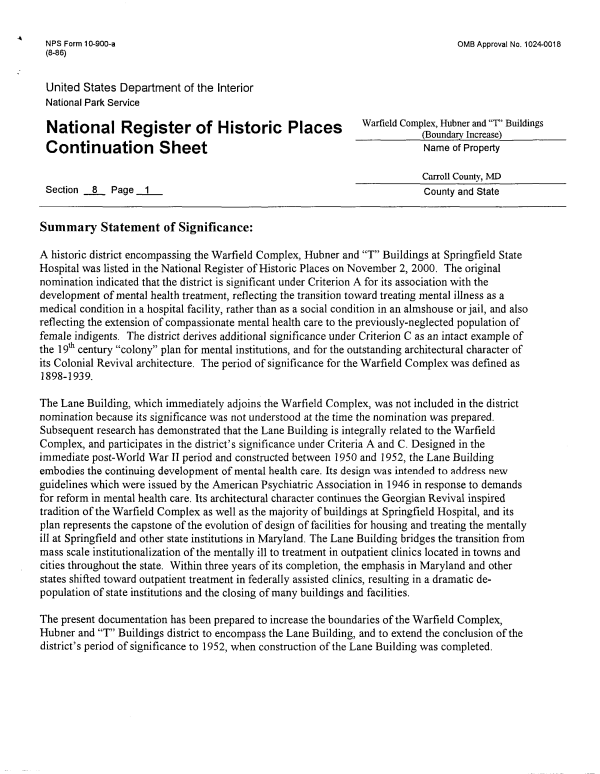 |
||||
|
DEPARTMENT OF HOUSING AND COMMUNITY DEVELOPMENT, MARYLAND HISTORICAL TRUST (Historic Sites Survey) var.d. MSA SE16-7 Image No: se16-7-0314 Enlarge and print image (70K) |
 |
||||
|
DEPARTMENT OF HOUSING AND COMMUNITY DEVELOPMENT, MARYLAND HISTORICAL TRUST (Historic Sites Survey) var.d. MSA SE16-7 Image No: se16-7-0314 Enlarge and print image (70K) |
| NPS Form 10-900-a OMB Approval No. 1024-0018 (8-86) United States Department of the Interior National Park Service National Register of Historic Places WarflddCompS^eSeasI)Buildings Continuation Sheet Name of Property Carroll County, MD Section 8 Page 1 County and State Summary Statement of Significance: A historic district encompassing the Warfield Complex, Hubner and "T" Buildings at Springfield State Hospital was listed in the National Register of Historic Places on November 2, 2000. The original nomination indicated that the district is significant under Criterion A for its association with the development of mental health treatment, reflecting the transition toward treating mental illness as a medical condition in a hospital facility, rather than as a social condition in an almshouse or jail, and also reflecting the extension of compassionate mental health care to the previously-neglected population of female indigents. The district derives additional significance under Criterion C as an intact example of the 19th century "colony" plan for mental institutions, and for the outstanding architectural character of its Colonial Revival architecture. The period of significance for the Warfield Complex was defined as 1898-1939. The Lane Building, which immediately adjoins the Warfield Complex, was not included in the district nomination because its significance was not understood at the time the nomination was prepared. Subsequent research has demonstrated that the Lane Building is integrally related to the Warfield Complex, and participates in the district's significance under Criteria A and C. Designed in the immediate post-World War II period and constructed between 1950 and 1952, the Lane Building embodies the continuing development of mental health care. Its design was intended to address new guidelines which were issued by the American Psychiatric Association in 1946 in response to demands for reform in mental health care. Its architectural character continues the Georgian Revival inspired tradition of the Warfield Complex as well as the majority of buildings at Springfield Hospital, and its plan represents the capstone of the evolution of design of facilities for housing and treating the mentally ill at Springfield and other state institutions in Maryland. The Lane Building bridges the transition from mass scale institutionalization of the mentally ill to treatment in outpatient clinics located in towns and cities throughout the state. Within three years of its completion, the emphasis in Maryland and other states shifted toward outpatient treatment in federally assisted clinics, resulting in a dramatic depopulation of state institutions and the closing of many buildings and facilities. The present documentation has been prepared to increase the boundaries of the Warfield Complex, Hubner and "T" Buildings district to encompass the Lane Building, and to extend the conclusion of the district's period of significance to 1952, when construction of the Lane Building was completed. |